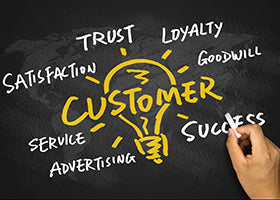
By Victor Hester, Vice President, Operations
In my last blog post I wrote about the true value of an AS-9100 system, and as part of that document, I touched on “customers”. In this blog I would like to expound on the topic of customers.
Companies are in business to achieve one thing for their shareholders, and that is VALUE. Let us look at that sentence ……there is no mention of “customer”, it is not even implied. But if customers are required, why don’t we have the word customer in it. Customers are the “How” we create value, where the sentence above is “WHY” we are in business. Subtle differences but very important.
Customers are not just a “How”, they are the only “How”. We create value by solving a problem for a customer, or by doing something for a customer that is not part of their core competency, but is in ours. Who do you sell a service to if not a customer? Who needs that new shiny computer if not a customer? Who are you sending your quotes to if not a customer? I know of no way to run a business without customers.
Few things in business are truly binary, they are usually shades of grey as options present themselves. But customers? They are not optional, they are required 100% of the time. If you have no customers, you have no business.
With something so imperative, why do companies spend so little time with, or talking to their customers? Sure, most companies have salespeople, and they talk with customers…. right? But is that the only person inside the company who needs to know the customer's needs? Who else needs to know? I will argue that not only should others have real and regular conversations with the customers, but it is critical to do so if we desire a happy ongoing customer.
There is nothing wrong organizationally with having a single point of contact for the customer, and that would typically be a salesperson or a program manager. However, many people inside the company SHOULD KNOW the customer, or at least the customer’s needs and how that relates to their job internally. How can anyone in the company fulfill the customer’s needs if they don’t know the customer’s needs of? Having a single point of contact for the customer is fine, but it then puts the onus on the salesperson or the PM to share customer information with others in the organization. This is extremely hard to do effectively.
The goal is to have happy returning customers who get what they want, in the way they want it... Don’t gloss over that last point, the relationship is two ways, the sales fuel your economic engine, and it also runs the economic engine of the customer. If either is not true, it will be a short-term relationship.
Customers make their buying decisions based on these basic values vs:
Each customer is unique and has their own set of business issues. Treating all customers the same is a quick way to disappoint a customer, and a disappointed customer is looking for someone else to solve their issues because you have not. So, what does your customer need from you to be successful?
Here at One Stop Systems, not only does a customer have a salesperson, or a PM, but a team of people that care about every level of the relationship. For example our VP of Engineering at OSS, Julia Elbert, sits in on many calls a week with our customers. She also is constantly meeting with vendors, so she has the knowledge of what solutions are coming to help to solve our customers' issues. She is the first person to say, “let’s ask the customer”, because she knows and understands that her job is not to create a solution, it is to create a solution for that customer that fulfills their expectations.
At OSS, we bring all the resources together to support the customer. I personally go on sales calls to meet potential customers, particularly when there are customers' concerns regarding quality or availability of products. I strive to fully understand not only what the customer wants, but what they need. They may not even know what they need, but by learning their issues I can develop the best solution.
Knowing and understanding the customer is the key to having long term relationship. Customers issues change over time, so what the problem is today may not be the problem in the future. Do not get complacent, continually assess what your customers need help with to solve their business issues.
Communication is key to having clients that come back year after year. A company can either depend on their sales team or their PMs to share customer information, or you can enable the organization to engage directly with the customer to ensure that their expectations are satisfied. It is amazing that many companies have drifted away from focusing on their customers, when it is noticeably clear that is the path to success.
Click the buttons below to share this blog post!
Comments will be approved before showing up.



Victor Paul Hester
February 22, 2023
Here is the citation for the Hedgehog concept mentioned above. Collins, J. (2001). Good to great. Random House Business Books